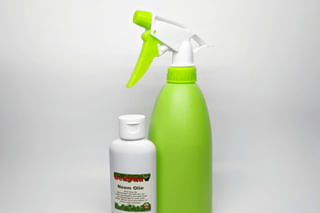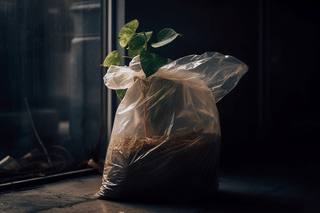How to get rid of mealybugs on houseplants
Struggling with mealybugs on your houseplants? Don't worry, I've got you covered! In this guide, I'll share my tried-and-true methods for getting rid of these stubborn pests and keeping your plants healthy and happy. From natural remedies to preventative measures, you'll find everything you need to know to become a pro at plant care. Say goodbye to mealybugs and hello to thriving houseplants!
 Have you ever found tiny white bugs on your houseplants? Don't worry, you're not alone! Mealybugs are a very common houseplant pest that can damage your plant if you don't remove them quickly. Luckily this is not very difficult and with a few simple steps, you can easily get rid of mealybugs and keep your houseplants thriving!
Have you ever found tiny white bugs on your houseplants? Don't worry, you're not alone! Mealybugs are a very common houseplant pest that can damage your plant if you don't remove them quickly. Luckily this is not very difficult and with a few simple steps, you can easily get rid of mealybugs and keep your houseplants thriving!
In this plant care guide, we're going to look at these topics:
Are you ready to remove the mealybugs from your plant and help it thrive again? Let's get started!
What do mealybugs look like?
When you're looking to get rid of pests on your houseplants, it's pretty easy to misidentify them. Perhaps you're not dealing with mealybugs, but you're dealing with some other common pests. So let's identify what mealybugs look like.
Have you noticed cotton-like balls or white, fuzzy stuff on your plants in the garden or those kept indoors as houseplants? Those cottony masses are a clear sign you're dealing with mealybugs.
They are small insects that can harm your plants by eating through their leaves, stems, or fruit. You can tell them apart from other pests because they have a white to light pink, soft body with a white fluff around them.
If you're not noticing any cotton balls on your plant, look for small bumps or white spots along the stems and underside of leaves. Sometimes you may even see ants on your plant because they are attracted to honeydew produced by mealybugs.
How do mealybugs harm your plants?

Mealybugs can be found on the leaves, stems, and roots of your houseplants. They are sap-sucking insects and can cause your plants to become weak and droopy.
They feed on the sap of the plant, so they remove a lot of the essential nutrients the plant stores to be able to grow properly. Mealygubs attach themselves to the stems, leaves, and undersides of leaves. They create their honeydew, a sticky substance, in those places on your plant.
Once the honeydew hardens, it becomes a breeding ground for mold and other harmful bacteria. As a result, mealybugs can damage your plant's growth and cause it to yellow and wilt.
Mealybugs can easily jump from plant to plant, so make sure to remove the infested plant and keep it away from your other plants. This will help to prevent the spreading of the pest to your healthy plants.
How can you get rid of mealybugs?
Once you've identified you're dealing with mealybugs, it's time to remove them from your plant to prevent any (further) damage.
One way to remove mealybugs is to use a cotton swab soaked in rubbing alcohol to wipe off the bugs. The alcohol dehydrates the mealybugs and kills them instantly. Be sure to pay close attention to hard-to-reach areas and also check under the leaves. Mealybugs reproduce very quickly, so it's essential to get all of them in one go.
Another way to eliminate mealybugs is to use a spray containing insecticidal soap or neem oil. Insecticidal soap destroys the protective waxy covering on the bugs and then dehydrates them, while neem oil damages their ability to reproduce. Always read the label before using any insecticide.
How can you prevent mealybugs in the future?
Once you've gotten rid of the infestation on your houseplant, it's important to take some steps to prevent mealybugs in the future.
Keep your plants healthy
The best way to avoid mealybug infestations is to keep your plants healthy. Maintain proper lighting, water, and soil conditions, so your plants are not stressed, which makes them more prone to pest infestations.
Isolate new houseplants
Another method of prevention is to keep any new houseplants separate from the rest of your plants for a few weeks to monitor for any pests, including mealybugs, before putting them closer to the rest of your plants.
Once you've put all of your plants together, you should regularly inspect your plants for any signs of bugs or white fluff. Remember to check under the leaves, where mealybugs often hide.
Prevent over-fertilizing your plants
It's also smart to avoid over-fertilizing your plants, as this can attract mealybugs to your garden. Instead, use a balanced and moderate amount of fertilizer that's appropriate for the specific plants you're growing.
Keep your plant dust-free
When it comes to keeping houseplants safe from mealybugs, be sure to dust them regularly with a damp cloth or sponge. Mealybugs can easily be removed during dusting, which helps avoid infestations.
By keeping your houseplants dust free, you're almost automatically inspecting them and by keeping them clean and dust-free, you get the opportunity to catch mealybugs early on.
How do I dispose of plants infected with mealybugs?
If you can't get rid of the mealybugs or the infestation is too large, you should throw the plant away but do so safely. You can start by putting the whole plant in an airtight plastic bag, sealing it tight, and throwing it away outside. This will prevent the bugs from spreading to other plants.
Can mealybugs harm humans or pets?
Mealybugs are tough pests for your houseplants, but they're not dangerous to you or your pets, so all you have to worry about helping your plants thrive.
Thank you for reading this post! I hope it helps you to keep your plants healthy and beautiful! If you're looking for more guides on specific plants, you can always request a plant guide to get a guide for the plant you have trouble with.
Test your plant care knowledge
Quiz completed!
Want to learn more? Sign up for my newsletter to receive free tips in your inbox!
Sign up now!






